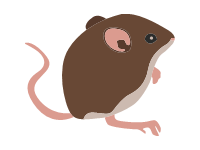| |
As its name suggests, the house mouse thrives wherever there are people, particularly in farm buildings, warehouses, sheds and garages, although it is no longer a common resident of our homes. It eats grains, seeds, roots, fungi and insects, and can be a serious pest of grain stores. House mice construct a series of tunnels to live in. Females can have up to 10 litters a year of four to eight young.
| |
The species appears to be present on all Japanese islands. It inhabits forests, grasslands, and cultivated fields, including rice paddies, at any altitude.Though occupying the same broad ecological niche as A. argenteus, the two species prefer different microhabitats: A. argenteus prefers dense canopy, while A. speciosus prefers open secondary forests. Large Japanese field mice forage primarily at night, likely to avoid predation They are omnivores but mostly known to be seed-eating mice, particularly around autumn and winter, as the mice hoard acorns and walnuts, which comprise 13-100% of their food. This makes them effective seed dispersers. Mast seeding can have serious effects on field mouse populations, including increases in overwinter survival, winter reproduction, and population density.
| |
The long-haired rat can be distinguished by its very long, coarse guard hairs that form an outer layer to protect the softer underfur.The species is generally a light grey colour with the black guard hairs giving and overall greyish speckled appearance.This distinguishes them from the tan or brown colouration of many other rat species.A male long-haired rat can grow to an average size of 187 mm with a tail length of approximately 150 mm while a female can grow to an average of 167 mm with an approximate tail length of 141 mm.The average weight for males is 156 g and for females is 112 g. Long-haired rats typically occur in temperate, sub-tropical, desert and hummock grasslands regions. However, during a plague eruption, they can be found in virtually every habitat including farm outbuildings and homesteads as well as invading cultivated pastures such as sorghum and oats. However, when population numbers are low, they are restricted to a much smaller range closer to sources of food and water.
Long-haired rats rely on dense vegetation or burrows for shelter. Their burrows can range in complexity from a simple shallow passage to a structure with 20 meters of complex tunnels which lead to multiple chambers.
| |
Satin is the name given to a coat type that has a metallic shine to it. Darker colours are harder to determine the satin effect on than lighter colours, and therefore lighter colours are more usually shown in the satin sectionThey live animals mainly in the United States. body size, they are not inferior to large rats. The trunk is long, thin. The tail is also long, is the color of the main color. mouse body is covered with a soft, rather short fur. The colors are different.
| |
small to medium-sized rodents characterized by the harsh, inflexible spiny hairs of their upperparts. African spiny mice have large eyes and ears and scaly, nearly bald tails that are shorter than or about as long as the body. The tail is brittle and breaks off readily either as a whole or in part. The golden spiny mouse (Acomys russatus), found from Egypt to Saudi Arabia, is one of the largest, with a body up to 25 cm (9.8 inches) long and a shorter tail of up to 7 cm.
| |
A domestic mouse is inexpensive compared to larger pets and many other pet rodents, but mice are short-lived: typically only 2 to 3 years.
Mice are susceptible to drafts and may pick up colds and other flu-like conditions. Mice can also over-groom when stressed, leading to skin irritations and fur loss. Older mice are susceptible to tumors, especially breast cancer in females, as the mammary tissue is distributed around much of the body. Persistent problems should be referred to a veterinarian, although finding a veterinarian with experience treating mice can be difficult. Mice have a rapid reproduction rate; the gestation period is approximately 19 to 23 days. The average litter size is four to 12 young. In some instances, up to 30 young have been born. However, females have ten nipples, so they may only feed this many pups at any time. The pups in a larger litter are often weaker, smaller animals that can weaken the doe, increasing recovery time.
|
|
